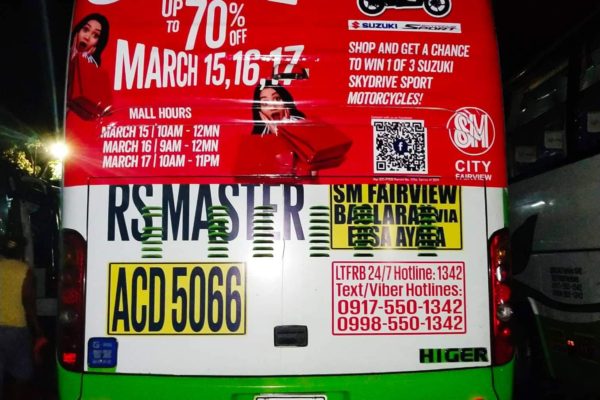Effective Transit Advertising Philippines to Expand Your Audience
Effective Transit Advertising Philippines to Expand Your Audience
Blog Article
Exactly How Transportation Advertising Can Change Public Transport Spaces Into Dynamic Marketing Platforms
Transit marketing holds significant potential to redefine public transport rooms into vivid marketing systems that engage and notify. By making use of innovative styles such as interactive booths and electronic displays, brands can not only reach a varied audience however likewise boost the general traveler experience. This strategy produces an unique possibility for brand names to get in touch with customers in a setup that is commonly neglected. As we explore the multifaceted benefits and advancing methods of transit marketing, it increases the concern of just how this change might redefine our communications with both brands and the metropolitan setting.
Benefits of Transportation Advertising

In addition, transit marketing is very cost-effective contrasted to traditional media. It allows marketers to attain high perceptions at lower prices, maximizing roi. The restricted target market of commuters provides a chance for brand names to communicate their messages to people that are frequently receptive during their traveling times.
Moreover, the dynamic nature of transit advertising and marketing permits projects to be upgraded often, ensuring that messaging remains prompt and appropriate. This adaptability can be essential in reacting to market patterns or promotional events, keeping the brand top-of-mind for consumers. Lastly, the prevalent presence of transportation advertising adds to brand recall; repeated direct exposure within familiar travel contexts strengthens brand name recognition and promotes consumer commitment, ultimately driving sales and enhancing brand name reputation.
Types of Transportation Advertising
Mass transit systems supply numerous formats for advertising and marketing, each accommodating different advertising approaches and audience engagement methods. One prominent type is external bus and train wraps, which cover the whole vehicle and develop a mobile billboard effect, enabling for high visibility in metropolitan settings. These wraps can catch attention as they pass through hectic roads, reaching a diverse audience.
An additional popular style is indoor advertising and marketing, which includes posters, digital screens, and advertisements on transportation seats. These placements engage guests throughout their trip, reinforcing brand messaging in a confined space. Digital displays, particularly, offer the advantage of vibrant content, enabling marketers to update messages in real-time.
Terminal advertising is also significant, including posters, banners, and interactive booths within transit stations. These ads leverage foot web traffic and can target particular demographics based on area.
Last but not least, promotional partnerships with transit authorities can bring about one-of-a-kind projects, such as themed transportation experiences or occasions, enhancing the general interaction with travelers. Each type of transit marketing uses distinctive benefits, allowing brand names to tailor their strategy to efficiently reach their target market within the general public transport environment.
Involving Commuters Properly
Commuters are increasingly inundated with marketing messages during their everyday journeys, making it important for brands to involve them in innovative methods. To catch attention in this congested area, marketers have to focus on creativity and significance. Using captivating visuals and succinct messaging can considerably enhance the probability of involvement.
Interactive elements, such as QR codes or increased fact attributes, can also change fixed ads into immersive experiences, cultivating a much deeper connection with the audience. Brands ought to concentrate on addressing commuters' passions and requirements, customizing messages to reverberate with their way of living, whether via promotions for regional services or services developed to enhance their travelling experience.
Furthermore, timing plays a critical role; tactically placing ads throughout top commuting hours can maximize presence and effect. Engaging commuters properly also involves leveraging social media sites assimilation, permitting passengers to share their experiences or promos directly from transit systems, thereby enhancing brand name reach.
Essentially, efficient interaction pivots on recognizing the traveler journey and producing engaging, interactive, and appropriate marketing experiences that not only capture interest but additionally drive action and loyalty. By doing so, brand names can change public transport into a dynamic marketing platform that reverberates with its audience.

Measuring Advertising Impact
Just how can brands properly analyze the effectiveness of their marketing projects in transportation environments? Measuring the impact of transportation advertising calls for a multifaceted method that integrates quantitative and qualitative metrics. One prevalent approach is tracking involvement via mobile analytics, where brands can examine foot website traffic patterns and application interactions previously, during, and after projects.
Surveys can offer important insights into brand recall and customer belief, allowing brand names to assess exactly how well their messages resonate with travelers. Furthermore, keeping an eye on social media sites involvement relevant to particular projects can disclose changes in public understanding and brand discussion.

Moreover, collaborating with transit agencies can enhance measurement precision, as they commonly possess detailed market information on ridership patterns. By incorporating these methodologies, brands can establish a thorough understanding of their advertising and marketing efficiency, guaranteeing that their campaigns not only get to however likewise influence their target audiences effectively.
Future Fads en route Marketing
A considerable change is anticipated in transportation marketing as technological improvements and altering customer behaviors reshape the landscape. Transit Advertising Philippines. The assimilation of digital displays and interactive media is expected to improve engagement, allowing brand names to provide dynamic web content that reverberates with diverse audiences. As public transport systems welcome clever technology, marketers will certainly leverage real-time data analytics to customize messages based on guest demographics and behaviors
Furthermore, increased fact (AR) is poised to reinvent the way commuters connect with promotions. By supplying immersive experiences, AR can change an ordinary journey into an engaging narrative that captures focus and cultivates brand loyalty. This technology will likely motivate marketers to develop even more experiential projects that drive customer interaction.
Sustainability is one more crucial trend affecting transit marketing. As ecological awareness grows, brand names will progressively seek to line up with green methods, using sustainable materials click for more info and advertising environment-friendly initiatives within their projects.
Conclusion
To conclude, transit marketing uses substantial benefits by enhancing brand name visibility and engaging a captive audience. With numerous formats, such as exterior covers and digital displays, it changes public transport into a dynamic marketing system. Reliable interaction approaches and robust dimension methods even more amplify its impact. As patterns develop, the potential for innovative interactions between travelers and brands is poised to expand, making sure that transit marketing remains a crucial element of modern advertising and marketing methods.
Transportation advertising and marketing holds significant possibility to redefine public transportation rooms into vivid advertising platforms that engage and notify. The pervasive existence of transit advertising and marketing adds to brand name recall; duplicated exposure within familiar travel contexts reinforces brand name awareness and fosters consumer loyalty, eventually driving sales and enhancing brand credibility.
Exactly how can brand names properly examine the performance of their advertising and marketing campaigns in transit environments?In verdict, transit advertising and marketing supplies significant benefits by enhancing brand visibility and involving a captive target market. Transit Advertising Philippines. As trends develop, the possibility for ingenious communications between brands Find Out More and commuters is poised to grow, making certain that transportation marketing remains a vital part of modern marketing techniques
Report this page